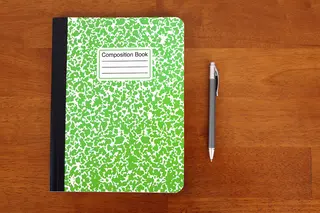
For jotting down notes, sketching elaborate monster rampages over cities, or just capturing your thoughts, people love a marbled composition notebook. These journals have been a staple of schools and nightstands for decades. No one holds any copyright to the design, and so a variety of manufacturers have circulated their own version of the familiar black-and-white bound notebooks. But where did they get started?
For answers, we need to look back to 10th-century China and 12th-century Japan. That’s when the practice of marbling pages came into widespread use. With traditional marbling, pages are hand-dipped in a solution consisting of various pigments. The result is a page that takes on a one-of-a-kind psychedelic pattern, with swirls and loops acting as an artistic flourish. (In Japan, it was known as Suminagashi.) People would then print over them. This type of marbling continued for centuries, with manufacture moving from Turkey to Western Europe and eventually to England, where publishers used the technique to add unique designs to book covers or bindings.
As publishing grew increasingly automated, the appetite for handmade designs remained. Eventually, industrial methods of marbling were used, making mass production of such designs possible. Modern notebooks with marbling began popping up in France and Germany in the middle of the 19th century before making their way to America in the late 19th and early 20th centuries. The marbling pattern created in Germany and seen both then and today as the inspiration for many composition book cover designs was known as the agate pattern. When that cover design caught on, it became easy for people looking for composition notebooks to spot one on a shelf. In a way, marbling became a way to “brand” this type of blank paper.
It’s not likely their popularity will ever abate. Because many composition books have stitched binding, they can be studier than your average notebook and may result in fewer lost or torn pages. Unlike ringed notebooks, they’re not likely to get snagged in backpacks or in drawers. Thanks to ruled pages, they also allow users to linearly organize their information. The flecked black-and-white cover acts as a signal of sorts for someone looking for a reliable method of recording thoughts and spurring creativity. When you see that familiar design, you know there’s no better place to let your imagination run wild.
A composition book may seem like a simple thing, but it can unlock a world of possibilities for you.



